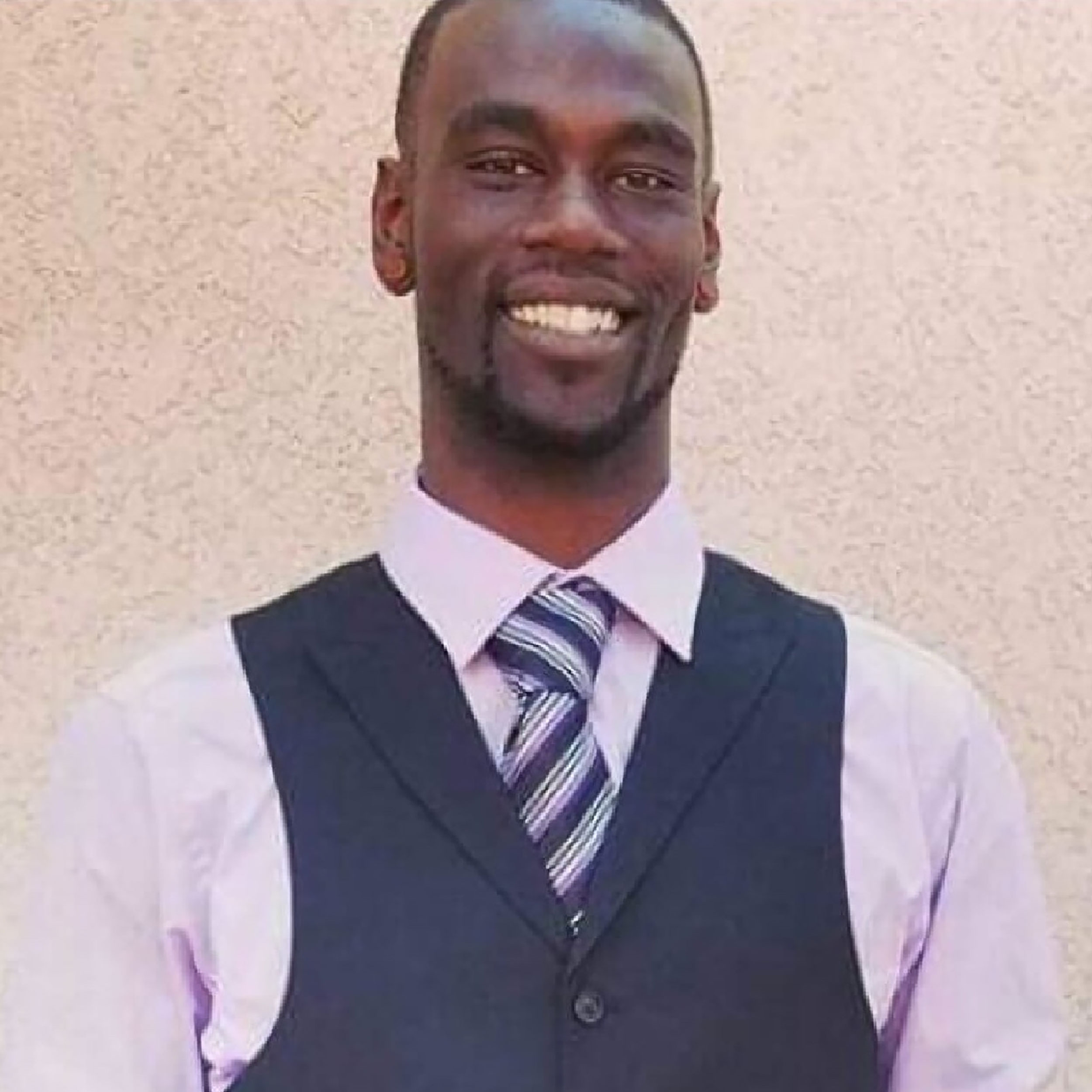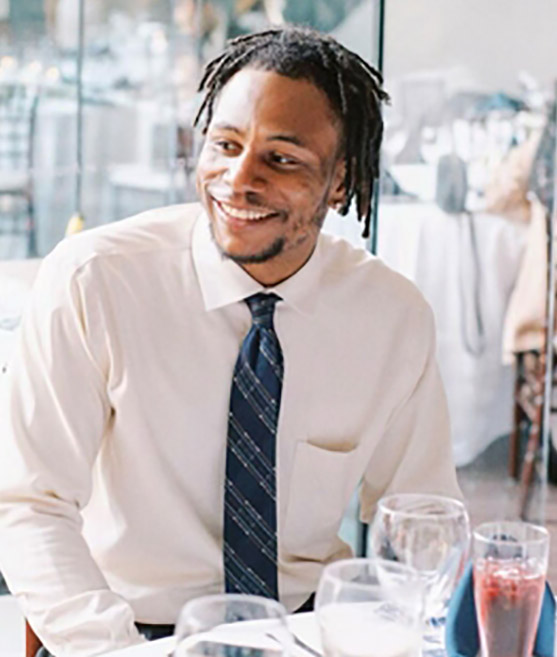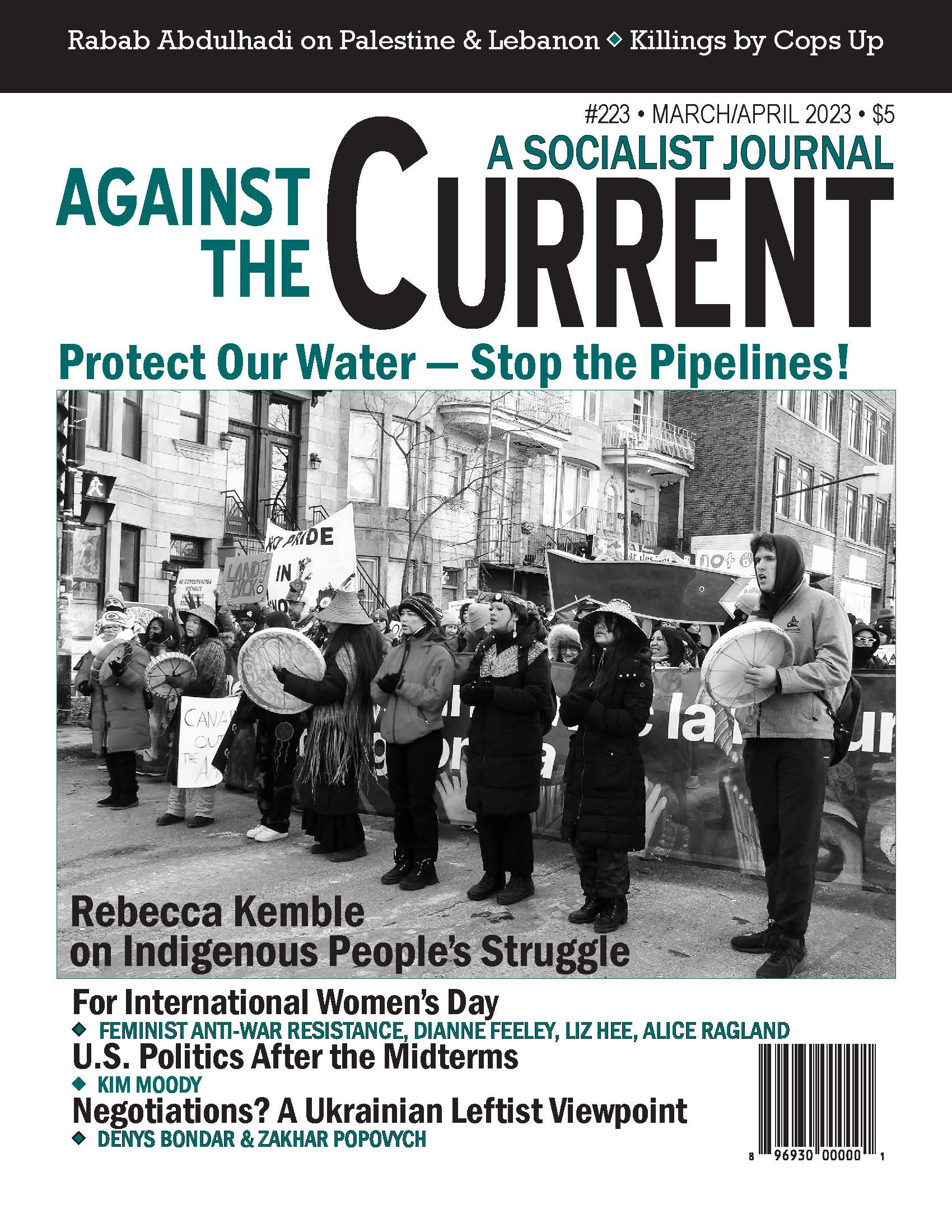Against the Current, No. 223, March/April 2023
-
Women's Rights, Human Rights
— The Editors -
Lives Yes, Pipelines No!
— Rebecca Kemble - Salvadoran Water Defenders
-
Killings by Police Rose in 2022
— Malik Miah -
View from the Ukrainian Left
— Denys Bondar and Zakhar Popovych -
Witness, Resilience, Accountability
— interview with Rabab Abdulhadi - Palestine Solidarity Activism Under Fire
- The Horror in Occupied Palestine
-
Nicaraguan Political Prisoners Freed, Deported
— Dianne Feeley and David Finkel -
Stuck in the Mud, Sinking to the Right: 2022 Midterm Elections
— Kim Moody -
Heading for the Ditch?
— David Finkel -
Paths to Rediscovering Universities
— Harvey J. Graff - International Women's Day, 2023
-
Demanding Abortion Rights in Russia
— Feminist Anti-War Resistance/ FAS (Russia) -
Before & After Roe: Scary Times, Then & Now
— Dianne Feeley -
Abolition. Feminism. Now.
— Alice Ragland -
#Adoption Is Trauma AND Violence
— Liz Hee - Reviews
-
Radical Memory and Mike Davis' Final Work
— Alexander Billet -
A Revolutionary's Story
— Folko Mueller -
James P. Cannon, Life and Legacy
— Paul Le Blanc -
The World of Professional Boxing
— John Woodford -
A Powerful Legacy of Struggle
— Jake Ehrlich -
War and an Irish Town
— Joan McKiernan - In Memoriam
-
Mike Rubin 1944-2022
— Jack Gerson
Malik Miah

BLACK PEOPLE ARE 13% of the U.S. population but 24% of those murdered by police. Over 1100 were killed by the police in 2022, an increase from 2021. Yet it is rare that any cop is disciplined or prosecuted.
In fact, Congress has opposed mandating data collection, doing the bidding of the pro-gun lobby. But since 2015, Mapping Police Violence has collected data on police shootings and killings across the country. The non-profit research group maintains a database of reported deaths at the hands of law enforcement, including people fatally shot, beaten, restrained and tasered.
The circumstances around the killings remain consistent. Police are basically “bullet proof” from prosecution because the courts and laws protect them when they claim the killing was justified because they “feared for their lives.”
But in 32% of cases last year, the person was fleeing before being killed. They were running or driving away — all cases in which experts say lethal force is unwarranted and also endangers the public.
The Case of Tyre Nichols
According to the first official statement from the Memphis Police Department about the arrest of Tyre Nichols, officers approached Nichols on January 7 to arrest him for a supposed traffic violation, then a “confrontation” occurred, and Nichols ran.
Once they caught up with him, five Black police officers punched, kicked, tasered and pepper sprayed Nichols. He laid in anguish on the ground, crying out for his mother whose home was only 80 yards away.
Nichols was finally taken to the hospital in critical condition and died three days later. Videos revealed such horrific violence unleashed by special police unit that the “Scorpion” team has been disbanded. The five are charged with second-degree murder.
There are several unusual circumstances in this case. First, the family and demonstrators immediately demanded evidence and videos disproved the police report.
None of the police cams or street lamp camera provided evidence that Nichols was driving recklessly. Nor did they substantiate the claim that Nichols tried to grab an officer’s gun.
Rather, they reveal the sustained attack the cops unleash on him and the callousness with which they banter among themselves while he is bloody and unconscious. Then the emergency medical workers come and fail to administer aid.
Usually if there is a video, it isn’t released for the family or the public to view. It is often kept under wrap for months.
Surveillance footage released on January 27 reveal a portrayal of what policing is in the city. The elite squad targets “high crime areas” and are free to do whatever they want. During the confrontation with Nichols, one officer took off his body cam and put it in his car. Another took photos of a dazed and handcuffed Nichols and sent them to at least six people. Not only are these acts in violation of police protocol, but they show their arrogance.
Second, it is extremely rare for police to be disciplined. But now that they have been charged, several other African American people have come forward and to tell stories about how they were stopped, harassed and beaten. It turns out that two of the five officers had been written up for their brutality.
While it was positive that the five cops were fired and charged quickly, the family’s lawyer pointed out that others present have not. The one white officer, who remained with the car, was also fired; seven more are under investigation. For its part, the Fire Department suspended the licenses and fired three EMT workers. But so far only Black officers are facing legal charges.
The Pattern
Those most likely to be stopped and killed are like Tyre Nichols, 29. He worked at FedEx, was an avid skateboarder, an amateur photographer and dad.

He seems remarkably similar to Keenan Anderson, 31, a Black high school teacher pulled over January 3 in Los Angeles. The police body cam footage from the scene shows multiple cops holding him down on the pavement. One officer appeared to hold his elbow against Anderson’s neck. As he begged for help, another tased him multiple times, sometimes for several seconds at a time.
Anderson’s cousin is Patrisse Cullors, co-founder of Black Lives Matter. She told a Guardian reporter that Anderson’s death could have been avoided. “It was a traffic accident. Instead of treating him like a potential criminal, police should have called the ambulance,” Cullors said. (The families of Tyre Nichols and Keenan Anderson provided these photos of their loved ones to indicate they were people with lives, not dehumanized objects.)
“If there was a policy in which traffic stops were met with unarmed professionals who come to the scene to help with whatever situation has happened, that would have prevented my cousin’s death. And that would have prevented so many other deaths.”
Ten percent of all those the police kill over the course of a year are initially stopped while driving. In 2020 that meant 86 people. An additional 10% are killed by police who respond to a mental health call; in 2020 that meant 109 murdered.
Questions About Black Cops
Qualified Immunity is the protection for police that makes legal shootings, beating and murder possible. It’s why few cops, even those charged, are ever convicted. Congress refuses to pass legislation to remove this protection for police.
What explains the quick response to the five African American cops? The beating was “normal” for police everywhere. Some believe it was because of a Black police chief. Others cited the fear of violent protest.
I believe that it reflects the changing social consciousness in the Black community about cops in general, including Black police. The change is a byproduct of the Black Lives Matter Movement that emerged in 2020 with the murder of George Floyd by cops in Minneapolis.
Nationwide there have been protests against police violence in other incidents, where local police and officials did not release videos of brutality and shooting deaths of Black people.
The deeper questions: Why do police departments set up elite units mainly targeting Black communities? Why was the Scorpion Unit set up in 2021?
“Hunter Dempster, an organizer with Decarcerate Memphis, a group pushing for accountability in the criminal justice system, said on Sunday that his organization has long been warning about the Scorpion team. He said the unit’s main mission had appeared to be conducting mass pullovers in poor areas.
“He described the officers in the unit as ‘violent bullies’ and said many residents had also questioned why the unit often used unmarked vehicles…” (New York Times, 1/29/23)
The Scorpion unit, like other special units, result in overcriminalizing the African American community, especially its youth. But even when the units are disbanded, the cops remain in the department.
In the aftermath of the 1967 Detroit rebellion, which was set off by a police raid on an after-hours celebration, police only intensified their stop-and-frisk policies.
The Michigan Civil Rights Commission and the Kerner Report outlined what needed to be done to end racial profiling and police violence. Instead the police department pushed back and by 1971 set up STRESS (Stop The Robberies, Enjoy Safe Streets).
STRESS teams were undercover for surveillance and decoy operations, supposedly arresting muggers and robbers. Over the next two years, STRESS teams murdered 22 civilians, all but one African American; six were shot in the back.
Opposition to the repressive police grew until a broad coalition organized for the abolition of STRESS. When Coleman Young ran for mayor in 1973 against the then current police chief, he promised to create “a people’s police department.”
Once elected — one of the first African-American mayors of a major U.S. city — Young abolished STRESS and issued an executive order to recruit more Black officers. At the time Detroit was 45% Black; the police force was 85% white.
The Case of Malice Green
The case of Malice Green, killed by Detroit police just 18 months after Los Angeles cops beat Rodney King, was remarkably similar to the Nichols and Anderson killings.
Green was stopped by an unmarked police car that had been following him. Two plainclothes officers, Walter Buzdyn and Larry Nevers, approached either side of his car; Nevers asked for his driver’s license.
According to the police report, Green reached for his glove box, with a “balled fist,” Nevers yelled that he should drop whatever he had. The two then jumped into the vehicle and began to beat his hand with their metal flashlights.
As the beating continued, additional uniformed police officers as well as EMS technicians arrived. EMS workers later reported that a uniformed officer pulled Green from the vehicle and hit him. Meanwhile Nevers hit Green in the ribs, at which point Green dropped his car keys and a piece of white paper. He was then handcuffed but suffered a seizure before EMS could treat him.
He was pronounced dead from blunt trauma to the head at the hospital. The police report claimed the officers retrieved four crack rocks and a closed knife.
Detroiters were shocked to discover Nevers had been part of the STRESS unit and one of five named in an excessive force lawsuit that resulted in the death of a 26-year old woman. The city settled the case for $275,000 but Nevers and the others remained on the force.
In the Green case, Buzdyn and Nevers were convicted of second-degree murder. Later they were retried and resentenced. A third officer was found not guilty.
Some people ask about the role of Black police officers. In the 1960s and 1970s when police forces were mainly white, the community demanded hiring Black police officers, and more Blacks elected to higher office.
I grew up in Detroit during the 1967 rebellion and afterwards, a common demand arose for more community control. Black people have since learned that racial composition does not transform its culture and mission of policing.
Policing was never meant to serve and protect average citizens. It was created to serve and protect the ruling class and its property, and to suppress formerly enslaved people and their descendants, as well as striking workers and protesters.
Black police officers are servants of the same violent racist system as white cops. Black police officers know when in civilian clothes they are treated like all Black people with racial contempt.
The root of police culture is white supremacy, racism and national oppression. The original sin of the United States, written into the Constitution, is acceptance of slavery (and the extra political power given to slaveholders) and oppression of Black people and other nonwhite populations.
Protests and demands were never directed at white cops alone. The sophisticated awareness of policing was always focused on winning democratic reforms and radical changes to the institution itself.
Memphis makes that clear. Cops are cops no matter their skin color. Police violence reflects the internalization of racist ideology.
What Comes Next
What’s ahead in Memphis will be a long road to win some justice. It is not for sure that the five will be convicted. But most people realize that disbanding special police forces and convicting police who brutally beat people is hardly enough.
Just two years after George Floyd’s murder, the modest police reforms promised in the wake of his horrific murder have been reversed or stopped as Congress and the Biden Administration have pushed for more funding to police departments.
Clearly the Justice for George Floyd multiracial movement was always about more than getting the white police officers who killed him arrested and prosecuted.
It was about winning legal changes nationally to change policing. Most importantly, the radical wing of the BLM movement continues to demand defunding the police and reimagining how a public security system is forged. The left wing goes further by calling for the system to be abolished.
A new culture is possible only by uprooting the old and creating a new safety force from the bottom up. These are democratic demands that are both immediate and transitional to changing the ruling system itself.
African Americans are smart about racism and white supremacy. Until the civil rights victories in the 1960s, few if any cops were Black. The demand was to change that. Some 50 years later, as Memphis shows, it did not change the police culture and function.
In a lesser-known part of his famous 1963 March on Washington “I Have A Dream “speech, King proclaimed, “We can never be satisfied as long as the Negro is the victim of the unspeakable horrors of police brutality.”
As long as the police cartel exists and is supported by both major parties, police killing will continue. It took a mass civil rights movement to end legal segregation. The same must happen to abolish policing and the corrupt criminal legal system.
March-April 2023, ATC 223

